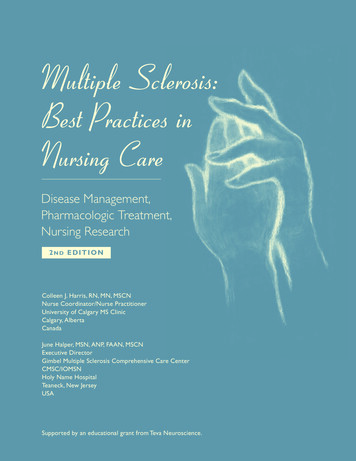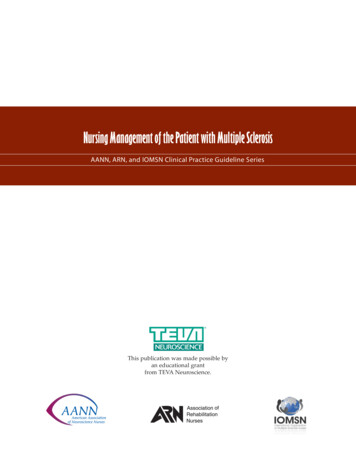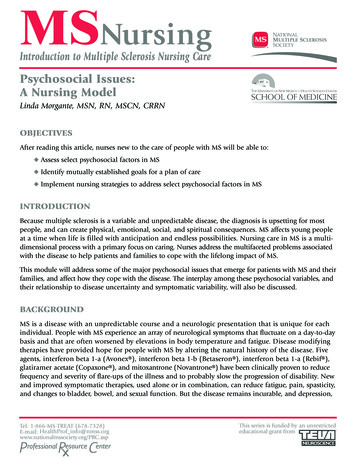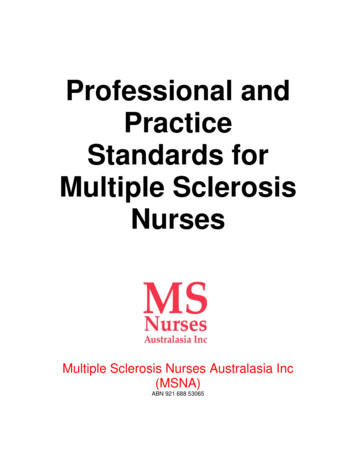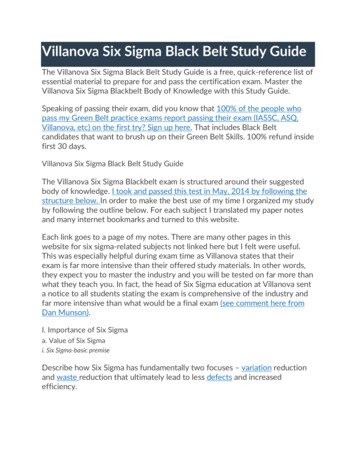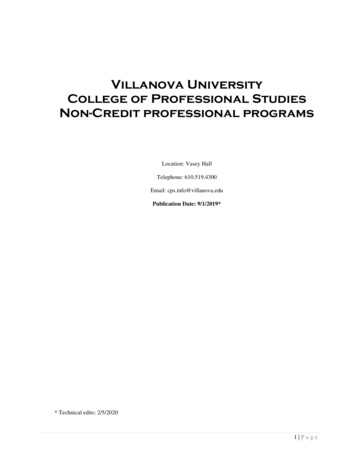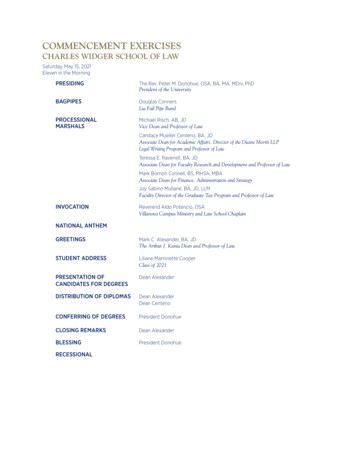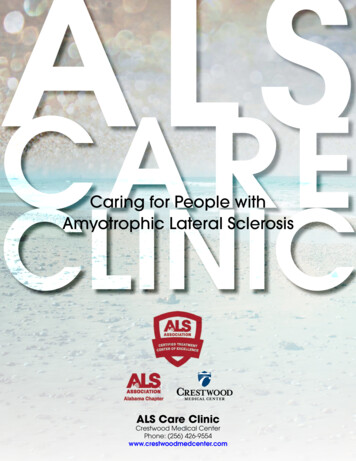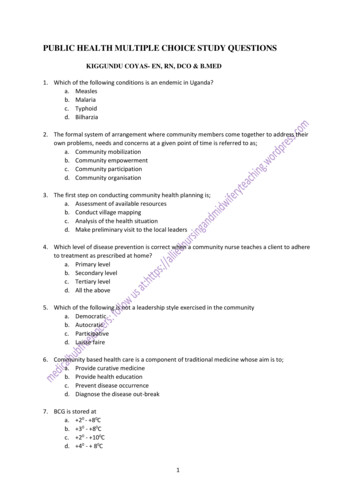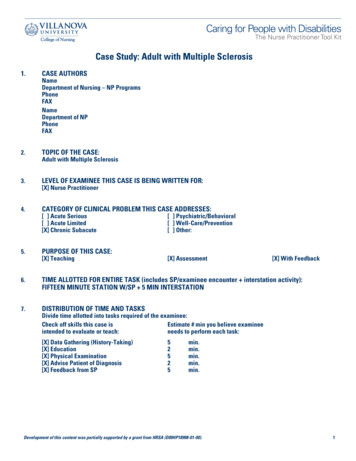
Transcription
Case Study: Adult with Multiple Sclerosis1.CASE AUTHORSNameDepartment of Nursing – NP ProgramsPhoneFAXNameDepartment of NPPhoneFAX2.TOPIC OF THE CASE:Adult with Multiple Sclerosis3.LEVEL OF EXAMINEE THIS CASE IS BEING WRITTEN FOR:[X] Nurse Practitioner4.CATEGORY OF CLINICAL PROBLEM THIS CASE ADDRESSES:[X] Acute Serious[X] Acute Limited[X] Chronic Subacute5.[X] Psychiatric/Behavioral[X] Well-Care/Prevention[X] Other:PURPOSE OF THIS CASE:[X] Teaching[X] Assessment[X] With Feedback6.TIME ALLOTTED FOR ENTIRE TASK (includes SP/examinee encounter interstation activity):FIFTEEN MINUTE STATION W/SP 5 MIN INTERSTATION7.DISTRIBUTION OF TIME AND TASKSDivide time allotted into tasks required of the examinee:Check off skills this case isEstimate # min you believe examineeintended to evaluate or teach:needs to perform each task:[X] Data Gathering (History-Taking)[X] Education[X] Physical Examination[X] Advise Patient of Diagnosis[X] Feedback from SP52525min.min.min.min.min.Development of this content was partially supported by a grant from HRSA (D09HP18998-01-00).1
Case Study: Adult with Multiple Sclerosis8.FACILITY/ROOMS RESERVED FOR THIS ACTIVITY:[X] Clinical Learning Lab/ SP Rooms[X] Auditorium[X] Other:9.[X] Seminar Rooms[X] CampusINTERACTION FORMAT:Participants[X] With SP Feedback[X] 1 Trainee, 2 SP (1 Adult and 1 Adolescent)10.[X] With VideotapeSETTING OF THE INTERACTION:[X] Nurse Practitioner Care11.FURNISHINGS IN THE EXAM ROOM:[X] Desk, Chairs, and Exam TableEQUIPMENT/PROPS IN THE EXAM ROOM:[X] X-Ray View Box[X] Stethoscope[X] Cardiac Monitor[X] Crutches[X] Other:[X] X-Ray Calipers[X] Tuning Fork[X] Roll Board[X] Collar - Type:[X] Reflex Hammer[X] Neuro Exam Kit[X] I.V. Pole SolutionEQUIPMENT/PROPS AT THE STUDENT CARRELS:[X] X-Ray View Box[X] Other:12.[X] X-Ray CalipersLIST POSSIBLE DIFFERENTIAL DIAGNOSES (asterisk actual diagnosis):*Multiple SclerosisMusculoskeletal Strain*Health MaintenanceCardiac Disease (HTN Tachycardia)Pain*13.PHYSICAL CHARACTERISTICS THE ACTUAL SP SHOULD HAVE:Gender:Age:Race/Ethnicity:Body Type:Ideal Height/Weight:14.[X] MaleRange 40-50[X] Female[X] Slender[X] Average[X] Overweight[X] Immaterial[X] Immaterial[X] Immaterial[X] Immaterial[X] ImmaterialESSENTIAL “REAL” PHYSICAL FINDING(s) OR ATTRIBUTES THE SP SHOULD HAVE:None, but will need to be in a wheelchair.Development of this content was partially supported by a grant from HRSA (D09HP18998-01-00).2
Case Study: Adult with Multiple Sclerosis15.PHYSICAL FINDINGS THE SP SHOULD NOT HAVE:N/A16.PHYSICAL EXAM REQUIRED:[X] Abdominal[X] Skin17.[X] Cardiac[X] Musculoskeletal[X] Respiratory[X] NeuroCASE REQUIRES THE SP TO SIMULATE THE FOLLOWING PHYSICAL FINDINGS:[X] Wheelchair Bound[X] Middle and lower back painINSTRUCTIONS FOR THE EXAMINERCASE INFORMATION: Patient is a 48yo female who is well known to your practice. She was diagnosed withrelapsing progressive MS in 2004. She is here today for routine health maintenance visit and because her sister wasrecently diagnosed with breast cancer. Her MS is managed by a local Neurologist and she sees a Pain Managementteam. She is scheduled to see the pain team today. VS afebrile-112-24-164/78Chief complaint: Pain and burning on urination and fever x 3 daysDURING THE ENCOUNTER:[X] Obtain a focused and relevant history[X] Perform a focused and relevant physical exam[X] Offer some initial recommendations to the patient and parent (see NOTE immediately below)The task in this case is to look at and facilitate health maintenance of a 48yo female.Development of this content was partially supported by a grant from HRSA (D09HP18998-01-00).3
Case Study: Adult with Multiple SclerosisSTANDARDIZED LIFE SKETCH18.Setting of Encounter: NP OfficeSP: Seated in wheelchair in exam room fully clothedThe Mother SP is sitting in waiting room.EXAMINER WASHES HANDS ON ENTERING EXAMINING ROOM19.What do you want the SP to say to the examinee's first query:SP: “There is so much going on with my family, I need to get checked out.”20.IF THE EXAMINER REMAINS SILENT, or acts as if waiting for more information, or asks anopen-ended question:SP: “I’m really nervous, my little sister was diagnosed with breast cancer a few months ago and I haven’thad a mammogram or GYN exam in YEARS.”A.HISTORY OF PRESENT ILLNESS/DIMENSIONS OF SYMPTOMS:21.Expand on your history and characteristics of major symptoms from onset to present in the form of a time line; ifpain, please include: onset, duration, location, quality, radiation, intensity, exacerbating, alleviating, pastexperience w/symptom(s).History given by SP:SP: “My last mammo was in 2009 and last GYN exam/PAP in 2008.”IF THE EXAMINER ASKS: “Why has it been so long since your last exams?”SP: “I have been a little busy with my MS.”IF EXAMINER ASKS: “How are you feeling physically?”SP: “I am in a terrible amount of pain today but am headed to the pain doctor when I leave here.”IF THE EXAMINER ASKS: “When did the pain get worse?”SP: “About 3 days ago.”IF THE EXAMINER ASKS: “Where is the pain? Can you describe it?”SP: “Middle and lower back spasms.”IF THE EXAMINER ASKS: “Was your medication working well until 3 days ago?”SP: “Yes.”IF THE EXAMINER ASKS: “When do you see your Neurologist again?”SP: “I have an appointment in a month but can call if I need to be seen sooner.”Development of this content was partially supported by a grant from HRSA (D09HP18998-01-00).4
Case Study: Adult with Multiple SclerosisIF THE EXAMINER ASKS, SP RESPONDS TO THE FOLLOWING QUESTIONS:Insomnia:SP: “Yes.”Fatigue:SP: “Yes.”Pain anywhere else:SP: “No.”Changes in vision:SP: ”Yes, increasingly blurry.”Self breast exams:SP: “No.”Sexual activity:SP: “Yes. I am in a monogamous relationship.”Last menstrual period:SP: “2 weeks prior.”Bowel patterns:SP: “No change, use suppository every 3 days or so for chronic constipation.”Appetite:SP: “Poor secondary to pain.”Bladder problems:SP: “Straight caths 3x day but becoming tougher because of loss of dexterity.”Musculoskeletal/Neuro:SP: “Increasingly difficult to transfer by herself and cannot stand without assistance.”Development of this content was partially supported by a grant from HRSA (D09HP18998-01-00).5
Case Study: Adult with Multiple Sclerosis22.IF THE EXAMINER ASKS about exercise:SP: “I go to PT 2 days a week when my insurance company will pay for it.”IF THE EXAMINER ASKS: “How long have you been in a wheelchair?”SP: “I would guess it has been all the time for about 4 years.”23.Psychosocial consequences: How does the problem influence or affect the pt?IF THE EXAMINER ASKS:SP: “It is really frightening first the MS now this scare.”24.Response to symptoms: What has the patient done about the symptoms (other than seeking health care)?IF THE EXAMINER ASKS:SP: “I just keep trying.”25.Meaning of the illness: patient's ideas/feelings about causes, implications, fears about problem/illness?SP: “I wouldn’t wish this on my enemies.”B.PAST MEDICAL HISTORY: HISTORIAN: SP26.Medical:MS with neurogenic bowel and bladder (2004)Perimenopausal (symptomatic)OsteoperosisRight hip fracture s/p fall (2009)27.Surgical:Right THA (2009)Implantable Pain Pump (2011)Colposcopy-no dysplasia (2005)28.Chief Complaint: “I need to get checked out.”29.Allergies:SP: “None that I know of.”Development of this content was partially supported by a grant from HRSA (D09HP18998-01-00).6
Case Study: Adult with Multiple Sclerosis30.Medications:MVI 1 po qdCalcium with D 600/400mg 1 po q 12hBoniva 150mg po q monthBaclofen pump (per pain management) 400mcg IT qdGabapentin 200mg po q8hrsCopaxone 20mg sq qdSenna tabs 2 tabs po q12hrsMiralax 17g po qdEstradiol/norethindrone 0.5/0.1mg 1 po qdStraight caths for self caths q8hrsD.FAMILY HISTORY:31.Current and past health of parents, sibs, adolescent:Mother: alive, 69yo, breast cancer 2009Father: alive, 70yoSister: 38yo breast cancer 2011Son: 13yo. No health issues32.Deaths: dates and age at death of family members:SP: “Oh, I don’t know but I think my mom’s mom had breast cancer too.”E.PSYCHOSOCIAL HISTORYPresent/Past:33.Marital status:Divorced, single mom w/ 13yo son. Has boyfriend of 3 years.34.Home Environment:Lives in ground floor apartment of a duplex, her parents live upstairs.37.Tobacco/alcohol/illicit drug use?:SP: “No.”38.Significant events in pt's life: stresses, pleasures, death, divorce, financial hardships?:I spend a lot of time home alone, busy with my son and helping organize his life. Thank goodness for myparents. Unemployed. Unable to drive. Gets social security disability plus help from her ex-husband.Case Study: Adult with Multiple SclerosisDevelopment of this content was partially supported by a grant from HRSA (D09HP18998-01-00).7
39:Employment:UnemployedF.MENTAL STATUS EVALUATION42.Past psychiatric history?No.43.Anxiety?Yes.44.Mood changes?No.45.Memory or cognitive changes?No.46.Disturbing thoughts or ideas?No.47.Other?No.G.FUNCTIONAL STATUS:49.Pt able to take care of daily activities? (school, dressing, washing self?)SP: “I can but I need more and more help because it is all just so hard and I am so slow.”H.OTHER:50.Other than HPI, any other medical/psychosocial problems the pt is currently facing?SP: “No.”51.What is your biggest worries/main concerns?Parent SP: “Make sure I don’t have any cancer either.”52.Patient expectations: what does the patient expect/want from health care provider?SP: “Help getting tests done.”Case Study: Adult with Multiple SclerosisDevelopment of this content was partially supported by a grant from HRSA (D09HP18998-01-00).8
53.Adolescent SP Appearance: clothing, grooming, etc. (ex: neat, disheveled, in hosp. gown, etc., or: clothingand/or appearance unimportant to the case)?Fully dressed in wheelchair neat and well put together.54.Affect/Behavior: body language, mannerisms, eye contact, angry, sad, talkative, nervous, happy to see NPtoday?Anxious.55.Do any questions posed by the examinee change the SP's appearance or affect (disturb either of the SPs ormake either sad, fearful, reassured)?No.56.Creating empathic opportunities: what do you want the SP to say, or what kind of behavior would create anopportunity in this case, for the examinee to express empathy?You are right. Your sister is young and combined with your family history, you have a right to beconcerned.Development of this content was partially supported by a grant from HRSA (D09HP18998-01-00).9
Case Study: Adult with Multiple SclerosisSKILLS PERFORMED1) Addresses patient2) Assists patient into gown and onto exam table3) Takes adequate health history4) Inspects pt head to toe5) Completes following exams:a. Neurob. Cardiacc. Respiratoryd. Breaste. Abdomenf.Musculoskeletalg. SkinCONTENT CHECKLISTCategory 1. Data gathering. I TOLD THE EXAMINER or /THE EXAMINEE ASKED ABOUT:1) Past medical and psycho-social history from parent and adolescent2) History of present chief complaint including onset and duration3) Management of problem4) Immunizations5) Diet and activity6) Allergies7) Medications8) Behaviors9) Living environment10) Management of CP - (therapies, home management)PHYSICAL EXAM EVALUATION: did the examinee perform:[X] Head to toe inspection[X] Neuro exam[X] MSK exam[X] Cardiac exam[X] Respiratory exam[X] Breast exam[X] Abdomen exam[X] Skin examDevelopment of this content was partially supported by a grant from HRSA (D09HP18998-01-00).10
Case Study: Adult with Multiple SclerosisSKILLS CHECKLISTI. DATA GATHERING SKILLSDid the examinee 1) Provide a safe environment for the adolescent?2) Allow the SP to finish opening statement without interruption?3) Get the chronology of the present concern from the beginning until now?4) Use “open-to-close cone” question style?5) Repeat or summarize information I’ve given at least once?II. INTERPERSONAL SKILLSDid the examinee 6) Offer encouraging, supportive or empathic comments?7) Demonstrate attentive listening?III. INFORMATION GIVING SKILLSRegarding the parent SP: Did the examinee 8) Explain reasons for recommendations?9) Ask about barriers to adherence/testing? Mammo for wheelchair dependent female? GYN office that ishandicap accessible?10) Check my understanding at least once and/or solicit the parent's questions?11) Use language I can understand?IV. ORGANIZATIONAL SKILLSDid the examinee 12) Demonstrate organizational skills during the entire encounter?V. PATIENT SATISFACTION13) Overall, I was satisfied with this NP/patient interactionDevelopment of this content was partially supported by a grant from HRSA (D09HP18998-01-00).11
Case Study: Adult with Multiple Sclerosis 30. Medications: MVI 1 po qd Calcium with D 600/400mg 1 po q 12h Boniva 150mg po q month Baclofen pump (per pain management) 400mcg IT qd Gabapentin 200mg po q8hrs Copaxone 20mg sq qd Senna tabs 2 tabs po q12hrs Miralax 17g po qd Estradiol/norethindrone 0.5/0.1mg 1 po qd Straight caths for self caths q8hrs
